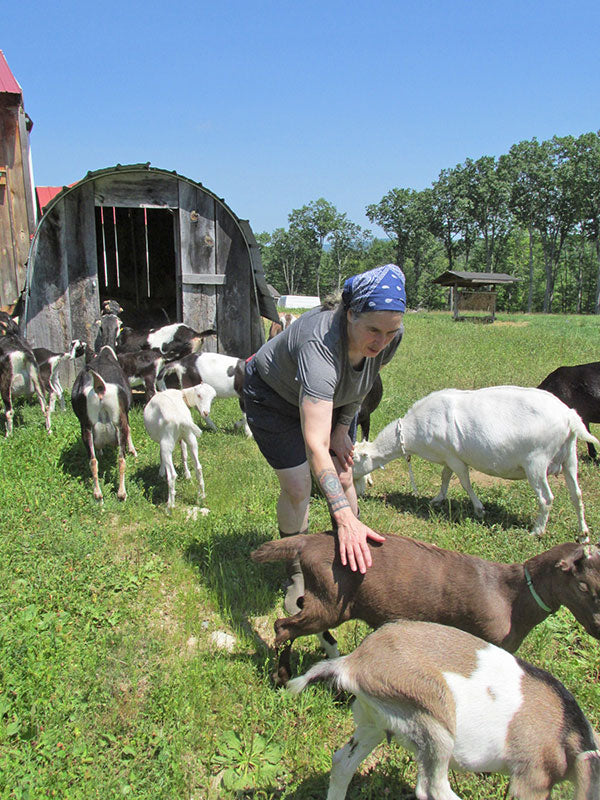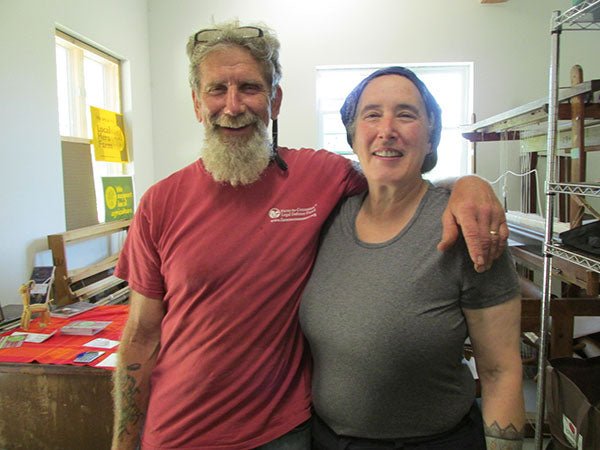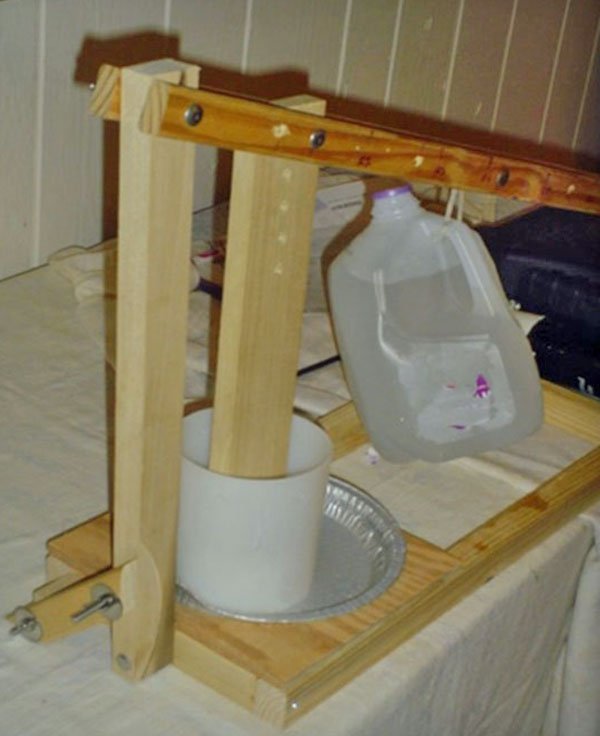
When you listen to Rachel Scherer talk about her goats, you can tell she knows exactly what they like and don’t like, as if she can read their minds. She learned everything she knows from the queen of her herd- Little White Goat. Rachel describes their relationship as a “mystical bond” and it certainly appears to be so.

Rachel and Little White Goat, the queen of her herd
13 years ago, when Rachel and her husband, Bruce decided to try raising goats on their 85 acre property, they were given a couple of Nubian-Saanen cross goats who had been raised with very little human contact. Rachel got the idea that if she had older, more mature goats around to model good behavior, life would be easier for everyone. So, she bought 2 mature LaManchas and they did, indeed, set a good example. So good in fact, she decided to build her herd with LaManchas. In the second year, she got Little White Goat.

From then until now, Little White Goat has been cuing Rachel about how to milk, how to feed, how to pasture and, in general, how to raise goats. As a result, the goats who have been bred for
temperament as well as their dairy qualities, are sweet and well behaved. When Rachel and Bruce want them to come down from the upper pasture, all they have to do is call and they come! When I asked Rachel about that, she modestly said, “They like to be with us.”

Coming down from an upper pasture

In general, goats do not like to get their feet wet. So, in the winter, when there is snow on the ground, Bruce clears a path for them to their favorite eating spot. He even cuts down a few hemlock trees so they can have fresh greens in their diet. In the summer, the goats like a diverse diet, so the couple lets them roam in large pastures where they can sample a little of this and a little of that.

Bruce leading the goats up a hill
Their Story
In 1981, when the Scherers had 2 young girls, they bought their property, (Heritage Fields Farm) intending to live a homesteading lifestyle. The woods had grown right up to the house, so they had to clear the land. They now have 15 acres of pasture.

They raised turkeys, chickens, sheep and a few pigs.

The dairy is 100% powered by the sun, with funding assistance from the MDAR Ag Energy Program, and the USDA Rural Energy Assistance Program.
When their girls grew up and moved out, they downsized everything because they didn’t need that much food. Besides, Rachel was working at the University of Massachusetts where she was a research fellow in the structural biology department for 28 years and Bruce had his own business restoring land to agricultural fields. The laying hens, broilers and hogs currently on the farm are raised by Bruce as a business, not as part of their homesteading.

Bruce has a lot of heavy equipment for his business
At that point, when they were empty nesters, they volunteered tracking and counting birds across North America and they helped to organize the very popular Garlic and Arts Festival. Through their expanding circle of festival farmer friends, they were inspired to spend more time tending their land. During that time, Rachel, who had been lactose intolerant all her life, discovered that she could eat sheep and goat’s milk cheese.

In 2005, Rachel decided to try raising goats and making cheese. It took the couple over 2 years, but they built their barn, milking parlor and dairy with their own hands (shown below). By 2013, they had decided to make a go of a commercial dairy, and had obtained all the necessary permits to begin selling raw milk and cheese.

The farm store and make rooms are around to the left.



Their peaceful, quiet milking parlor
The goats graze in the larger pastures in the summer. In the spring, they transition gradually from their winter feed to small pastures before they move to the larger fields. Otherwise, they can become bloated from eating too much fresh food.


Now, they have 16 adult females, 13 of whom are being milked once/day. (They had 36 kids born this spring and now there are 12 doelings remaining.) They have a fully licensed dairy and they sell their cheese at their farm store, farmer’s markets and retail grocery stores in the area. Raw milk is sold only at
the farm.
Their farm store is open 8am-6pm.

As you can see in the picture below, they offer a wide variety of products at very reasonable prices. (This article will be up for years, so please do not assume the prices haven’t changed if you are reading it years from now!)


They sell pork, chicken and goat meat.
There’s a beautiful loom in the corner where Rachel is making curtains for the room.

Making Cheese
 Originally, they were selling raw milk and making yogurt and kefir. The demand was so great for more that they began making labneh, chevre and feta, as well. (Rachel is working on recipes for aged cheeses, so that will be their next step.) Their customers also wanted the chevre to be seasoned, so they began offering different flavors of that, too.
Originally, they were selling raw milk and making yogurt and kefir. The demand was so great for more that they began making labneh, chevre and feta, as well. (Rachel is working on recipes for aged cheeses, so that will be their next step.) Their customers also wanted the chevre to be seasoned, so they began offering different flavors of that, too.
We donned our coats and booties to enter the make rooms. Both rooms have windows with beautiful views, so they are very pleasant places to be. Everything is stainless steel and, with the exception of the vats, they were able to purchase it at auction for pennies on the dollar.

Bruce was in the raw milk room, washing out the milking equipment.

There are 2 vats in that room. The one on the left was their first, but they rapidly outgrew that and bought a second one.

This room is for the raw milk only. It is inspected by the MDAR (Mass Dept. of Agricultural Resources). They come every month to sample the milk. Rachel and Bruce have the lowest bacterial count possible to measure- whey below the permitted amount. The second room, for the cheese, is inspected by the Department of Public Health. They come twice/year to inspect.
Their combination pasteurizing/cheese vat holds 35 gallons of milk:

This vat was shipped from Holland.
Space is always an issue in a make room, so everything is on wheels. There are 2 interesting exceptions. One is the sealer for the yogurt containers below. A piece of aluminum foil is put over the container and the top comes down to seal it.

The second is a peristaltic pump which transfers yogurt from the vat to the containers through a tube. The beauty of this piece of equipment is that only the tube has to be cleaned.

Typically, they make cheese Sunday-Wednesday and they package it on Thursdays and Fridays. Saturdays they are at the Amherst Farmers Market. Their dairy products are also available at two area coops: Green Fields Market (Greenfield), and the Quabbin Harvest Market (Orange). Simple Gifts (Amherst), Mill Valley (Hadley), and Natural Roots (Conway) also carry Little White Goat goodies at their farmstands.














































































































































